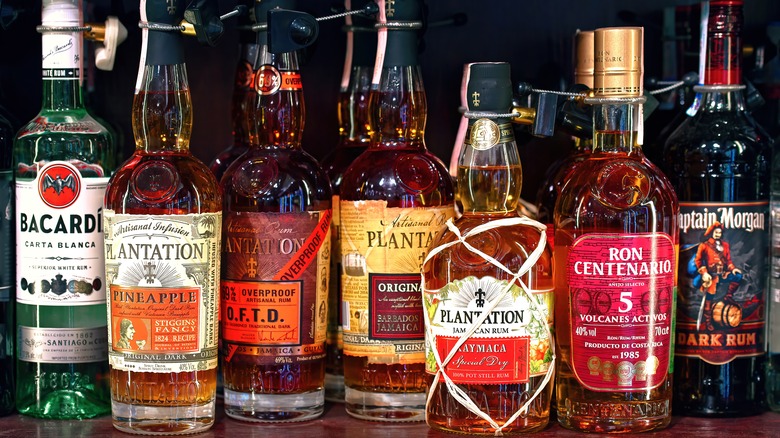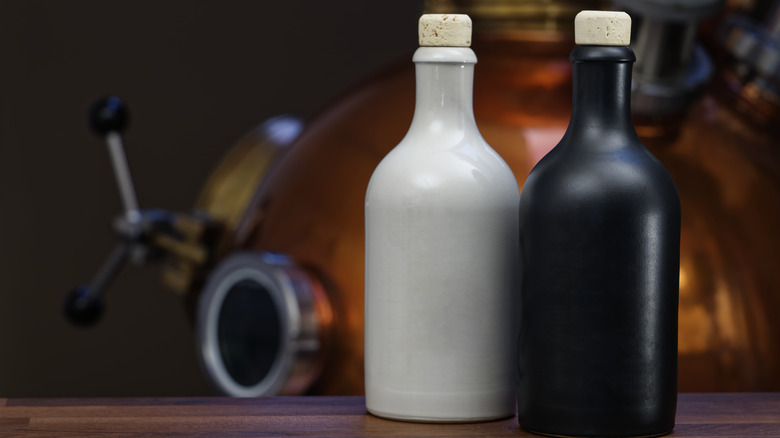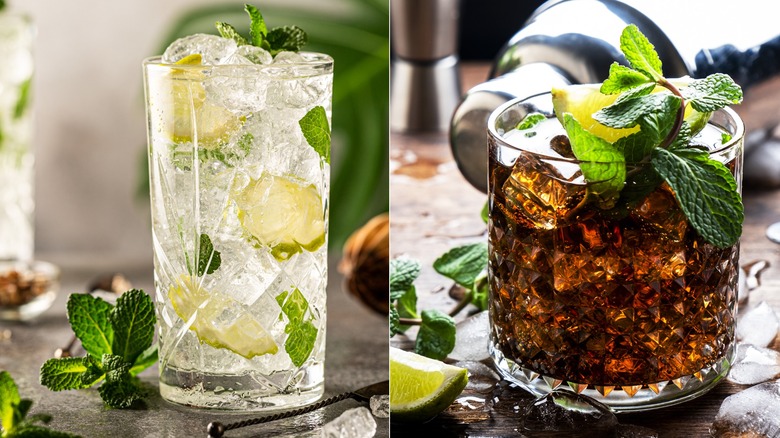White Rum Vs Dark Rum: What's The Difference?
Rum is a wonderfully versatile cocktail that's brilliant in anything from a warm-you-from-the-inside winter's day cocktail like a hot buttered rum to a refreshing, light, summertime mojito. It's an invaluable ingredient to cook with, too, and the next time you're looking for an amazing brunch, look no further than a rum-soaked challah French toast. You'll have to pick up a bottle of rum before you try any of those, and picking out the right type can be more confusing than you might think. There are a surprising number of options, but let's talk about the two most common.
When it comes to white and dark rum, their differences start right from the beginning. White rum gets its distinctive clarity by having all impurities removed during the distillation process, and that's done (in most cases) by using a column still. Dark rum, on the other hand, contains all of those impurities — which isn't a bad thing despite the negative connotations of the word.
Impurities aren't just important for the color; they also have a major impact on the taste. Because dark rum still contains essentially more traces of the ingredients used in the distillation process, it often has a stronger, richer, deeper flavor. Dark rum is generally described as having tasting notes that tend toward a smoky caramel, while white rum is sweeter and smoother. Does that mean they're not interchangeable in various cocktails and recipes? Not entirely.
White and dark rum are made with different processes
Both white and dark rum are made from the same ingredient: sugar cane. The juice extracted from the cane is fermented and turned into rum, but white and dark rum are made from entirely different processes, including the various stills and filtration levels we mentioned. But that's just the start. After the rums are distilled, they take a different route into the bottle and onto your liquor shelf. While some white rums are bottled immediately, others might be aged for a relatively short time in stainless steel tanks.
Dark rum, on the other hand, is typically aged for at least three years (although more expensive rums can spend decades aging before they're bottled and sold), and the barrel it spends time in is important. Barrels can be made from American white oak, European oak, or acacia, and they all impart distinctive flavors to the rum, giving it distinctive hints of vanilla, spices, honey, or caramel. When American white oak barrels are used, there's a good chance they've already been used to age whiskey, which adds to the character that dark rum develops as it ages. Sometimes, caramel coloring and other flavors are added to dark rum, while white rum is valued for purity, clarity, and a light sweetness.
White and dark rum stand out when they're used in different ways
If a cocktail or a recipe specifically calls for white or dark rum and you don't have exactly what's recommended, you can swap one for the other. It'll end up tasting different, but it's generally not going to taste bad. There are, however, some guidelines to remember if you want to use the correct rum for a particular application, especially when it comes to drinks.
If you're looking for something to drink straight or on the rocks, go for a dark rum, as it will be much more complex. Dark rum is also best used in cocktails with strong mixers. Those are drinks that can be as simple as a rum and coke, but you'll also want a dark rum so it stands out in something like a rum punch or rum-based versions of classic cocktails like a Manhattan, a Negroni, or a Mai Tai.
White rum, on the other hand, is perfect for cocktails where you want to focus on flavors other than the rum itself. Any kind of mojito best uses a white rum as it doesn't overpower the mint and fruit, and the same goes for a daiquiri. If you're adding rum to lemonade or another juice, or making a light and fizzy spritz, go for the fresh, clear, light flavor of a white rum. That said, experimentation is also perfectly fine!


